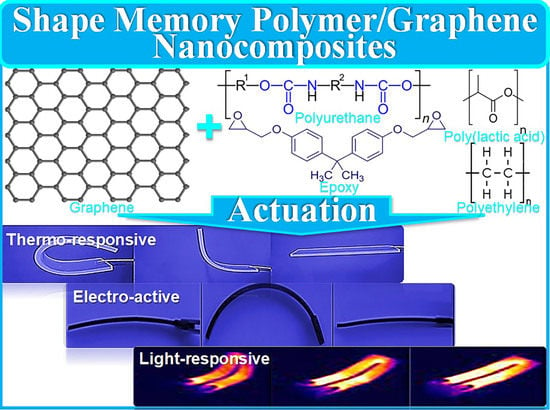Shape Memory Graphene Nanocomposites—Fundamentals, Properties, and Significance
Abstract
1. Introduction
2. Shape Memory Behavior of Polymers
3. Stimuli-Responsive Polymer Nanocomposites
3.1. Electroactive Shape Memory Nanocomposite
3.2. Thermoresponsive Shape Memory Nanocomposite
3.3. Light-Responsive Shape Memory Nanocomposite
3.4. Moisture-, Chemo-, Or Solvent-Responsive Shape Memory Nanocomposites
3.5. Magnetic-Responsive Shape Memory Nanocomposite
4. Shape Memory Effect in Polymer/Graphene Nanocomposites
5. Applications of Graphene-Based Shape Memory Nanocomposites
6. Conclusions
Author Contributions
Funding
Data Availability Statement
Acknowledgments
Conflicts of Interest
References
- Yazik, M.M.; Sultan, M. Shape Memory Polymer and Its Composites as Morphing Materials: Failure Analysis in Biocomposites, Fibre-Reinforced Composites and Hybrid Composites; Elsevier: Amsterdam, The Netherlands, 2019; pp. 181–198. [Google Scholar]
- Sloutski, A.; Cohn, D. Reverse thermo-responsive biodegradable shape memory-displaying polymers. Polymer 2023, 267, 125640. [Google Scholar] [CrossRef]
- Bai, Y.; Zhang, J.; Wen, D.; Gong, P.; Liu, J.; Ju, J.; Chen, X. A reconfigurable, self-healing and near infrared light responsive thermoset shape memory polymer. Compos. Sci. Technol. 2020, 187, 107940. [Google Scholar] [CrossRef]
- Zhang, C.; Lu, X.; Wang, Z.; Xia, H. Progress in utilizing dynamic bonds to fabricate structurally adaptive self-healing, shape memory, and liquid crystal polymers. Macromol. Rapid Commun. 2022, 43, 2100768. [Google Scholar] [CrossRef]
- Ze, Q.; Kuang, X.; Wu, S.; Wong, J.; Montgomery, S.M.; Zhang, R.; Kovitz, J.M.; Yang, F.; Qi, H.J.; Zhao, R. Magnetic Shape Memory Polymers with Integrated Multifunctional Shape Manipulation. Adv. Mater. 2019, 32, e1906657. [Google Scholar] [CrossRef] [PubMed]
- Panda, P.K.; Yang, J.-M.; Chang, Y.-H. Water-induced shape memory behavior of poly (vinyl alcohol) and p-coumaric acid-modified water-soluble chitosan blended membrane. Carbohydr. Polym. 2021, 257, 117633. [Google Scholar] [CrossRef]
- Panda, P.K.; Dash, P.; Biswal, A.K.; Chang, Y.-H.; Misra, P.K.; Yang, J.-M. Synthesis and Characterization of Modified Poly(vinyl alcohol) Membrane and Study of Its Enhanced Water-Induced Shape-Memory Behavior. J. Polym. Environ. 2022, 30, 3409–3419. [Google Scholar] [CrossRef]
- Lu, H.; Du, S. A phenomenological thermodynamic model for the chemo-responsive shape memory effect in polymers based on Flory–Huggins solution theory. Polym. Chem. 2013, 5, 1155–1162. [Google Scholar] [CrossRef]
- Basak, S.; Bandyopadhyay, A. Solvent Responsive Shape Memory Polymers-Evolution, Current Status, and Future Outlook. Macromol. Chem. Phys. 2021, 222, 2100195. [Google Scholar] [CrossRef]
- Wang, X.; Behl, M.; Lendlein, A.; Balk, M. Responses to single and multiple temperature-, medium-, and pH-stimuli triggering reversible shape shifts in hydrogel actuators. Mater. Des. 2023, 225, 111511. [Google Scholar] [CrossRef]
- Patel, G.M.; Shah, V.; Bhaliya, J.; Pathan, P.; Nikita, K. Polymer-Based Nanomaterials: An Introduction: Smart Polymer Nanocomposites; Elsevier: Amsterdam, The Netherlands, 2023; pp. 27–59. [Google Scholar]
- Kausar, A. Shape memory polystyrene-based nanocomposite: Present status and future opportunities. J. Macromol. Sci. Part A 2020, 58, 182–191. [Google Scholar] [CrossRef]
- Zhang, C.; Li, L.; Xin, Y.; You, J.; Zhang, J.; Fu, W.; Wang, N. Development of Trans-1,4-Polyisoprene Shape-Memory Polymer Composites Reinforced with Carbon Nanotubes Modified by Polydopamine. Polymers 2021, 14, 110. [Google Scholar] [CrossRef] [PubMed]
- Panda, P.K.; Dash, P.; Yang, J.-M.; Chang, Y.-H. Development of chitosan, graphene oxide, and cerium oxide composite blended films: Structural, physical, and functional properties. Cellulose 2022, 29, 2399–2411. [Google Scholar] [CrossRef]
- Rouhana, R.; Stommel, M.; Stanko, M.; Muth, M. Novel Method of Carbon Precursor Masking to Generate Controlled Perforations in a Carbon Film. Macromol 2022, 2, 554–561. [Google Scholar] [CrossRef]
- Taherzadeh, M.; Baghani, M.; Baniassadi, M.; Abrinia, K.; Safdari, M. Modeling and homogenization of shape memory polymer nanocomposites. Compos. Part B Eng. 2016, 91, 36–43. [Google Scholar] [CrossRef]
- Zhang, F.; Yang, K.; Liu, G.; Chen, Y.; Wang, M.; Li, S.; Li, R. Recent Advances on Graphene: Synthesis, Properties, and Applications. Compos. Part A Appl. Sci. Manuf. 2022, 160, 107051. [Google Scholar] [CrossRef]
- Chen, L.; Shen, Y.; Liu, Z.; Song, Q.; Jiang, Y. Experimental and modeling investigation on thermodynamic effect of graphene doped shape memory epoxy composites. Polymer 2021, 239, 124430. [Google Scholar] [CrossRef]
- Saud, S.N.; Bakhsheshi-Rad, H.; Yaghoubidoust, F.; Iqbal, N.; Hamzah, E.; Ooi, C.R. Corrosion and bioactivity performance of graphene oxide coating on TiNb shape memory alloys in simulated body fluid. Mater. Sci. Eng. C 2016, 68, 687–694. [Google Scholar] [CrossRef]
- Abolhasani, D.; Moon, B.; Kang, N.; VanTyne, C.J.; Moon, Y.H. High-Performance Cu-Al Shape Memory Alloy in Ternary Combination with Graphene Fabricated by Powder Bed Fusion Process. Social Science Research Network; Elsevier: Amsterdam, The Netherlands. [CrossRef]
- Zhao, W.; Li, N.; Liu, L.; Leng, J.; Liu, Y. Mechanical behaviors and applications of shape memory polymer and its composites. Appl. Phys. Rev. 2023, 10, 011306. [Google Scholar] [CrossRef]
- Xia, Y.; He, Y.; Zhang, F.; Liu, Y.; Leng, J. A review of shape memory polymers and composites: Mechanisms, materials, and applications. Adv. Mater. 2021, 33, 2000713. [Google Scholar] [CrossRef]
- Prathumrat, P.; Tiptipakorn, S.; Rimdusit, S. Multiple-shape memory polymers from benzoxazine–urethane copolymers. Smart Mater. Struct. 2017, 26, 065025. [Google Scholar] [CrossRef]
- Rahmalina, D.; Rahman, R.A. Ismail Improving the phase transition characteristic and latent heat storage efficiency by forming polymer-based shape-stabilized PCM for active latent storage system. Case Stud. Therm. Eng. 2022, 31, 101840. [Google Scholar] [CrossRef]
- Firouzeh, A.; Salerno, M.; Paik, J. Stiffness Control With Shape Memory Polymer in Underactuated Robotic Origamis. IEEE Trans. Robot. 2017, 33, 765–777. [Google Scholar] [CrossRef]
- Jose, S.; George, J.J.; Siengchin, S.; Parameswaranpillai, J. Introduction to Shape-Memory Polymers, Polymer Blends and Composites: State of the Art, Opportunities, New Challenges and Future Outlook:Shape Memory Polymers, Blends and Composites; Springer: Berlin, Germany, 2020; pp. 1–19. [Google Scholar]
- Bhanushali, H.; Amrutkar, S.; Mestry, S.; Mhaske, S. Shape memory polymer nanocomposite: A review on structure–property relationship. Polym. Bull. 2022, 79, 3437–3493. [Google Scholar] [CrossRef]
- González-Jiménez, A.; Bernal-Ortega, P.; Salamanca, F.M.; Valentin, J.L. Shape-Memory Composites Based on Ionic Elastomers. Polymers 2022, 14, 1230. [Google Scholar] [CrossRef]
- Gowri, M.; Latha, N.; Rajan, M. Fiber-and Fabric-Reinforced Shape-Memory Polymers: Shape Memory Composites Based on Polymers and Metals for 4D Printing; Springer: Berlin, Germany, 2022; pp. 267–286. [Google Scholar]
- Nam, N.D.; Tuan, V.A.; Yen, N.H.; Van Lap, D.; Khanh, P.M. A study of phase transformation in shape memory alloy CuAl9Fe4. J. Mech. Eng. Res. Dev. 2019, 42, 72–75. [Google Scholar] [CrossRef]
- Du, H.; Liu, L.; Zhang, F.; Leng, J.; Liu, Y. Triple-shape memory effect in a styrene-based shape memory polymer: Characterization, theory and application. Compos. Part B Eng. 2019, 173, 106905. [Google Scholar] [CrossRef]
- González, J.; Ardanuy, M.; González, M.; Rodriguez, R.; Jovančić, P. Polyurethane shape memory filament yarns: Melt spinning, carbon-based reinforcement, and characterization. Text. Res. J. 2022, 93, 957–970. [Google Scholar] [CrossRef]
- Zhang, X.; Li, J.; Liang, Z.; Kan, Q. Design and finite element simulation of shape memory polyurethane self-deforming structures. Eng. Fail. Anal. 2022, 139, 106446. [Google Scholar] [CrossRef]
- Pezzin, S.H. Mechanism of Extrinsic and Intrinsic Self-Healing in Polymer Systems: Multifunctional Epoxy Resins: Self-Healing, Thermally and Electrically Conductive Resins; Springer: Berlin, Germany, 2023; pp. 107–138. [Google Scholar]
- Liu, X.; Chakraborty, A.; Luo, C. Fabrication of micropatterns on the sidewalls of a thermal shape memory polystyrene block. J. Micromechanics Microengineering 2010, 20, 095025. [Google Scholar] [CrossRef]
- Sarwate, P.; Chakraborty, A.; Garg, V.; Luo, C. Controllable strain recovery of shape memory polystyrene to achieve superhydrophobicity with tunable adhesion. J. Micromech. Microeng. 2014, 24, 115006. [Google Scholar] [CrossRef]
- Cox, L.M.; Killgore, J.P.; Li, Z.; Long, R.; Sanders, A.W.; Xiao, J.; Ding, Y. Influences of Substrate Adhesion and Particle Size on the Shape Memory Effect of Polystyrene Particles. Langmuir 2016, 32, 3691–3698. [Google Scholar] [CrossRef] [PubMed]
- Safi, M.; Hassanzadeh-Aghdam, M.K.; Mahmoodi, M.J. A semi-empirical model for thermal conductivity of polymer nanocomposites containing carbon nanotubes. Polym. Bull. 2020, 77, 6577–6590. [Google Scholar] [CrossRef]
- Quadrini, F.; Santo, L.; Squeo, E.A. Solid-state Foaming of Nano–Clay-Filled Thermoset Foams with Shape Memory Properties. Polym. Technol. Eng. 2012, 51, 560–567. [Google Scholar] [CrossRef]
- Kalia, S.; Haldorai, Y. Organic-Inorganic Hybrid Nanomaterials; Springer: Berlin, Germany, 2015. [Google Scholar]
- Peng, Q.; Wei, H.; Qin, Y.; Lin, Z.; Zhao, X.; Xu, F.; Leng, J.; He, X.; Cao, A.; Li, Y. Shape-memory polymer nanocomposites with a 3D conductive network for bidirectional actuation and locomotion application. Nanoscale 2016, 8, 18042–18049. [Google Scholar] [CrossRef]
- Arash, S.; Akbari, B.; Ghaleb, S.; Kaffashi, B.; Marouf, B. Preparation of PLA-TPU-Nanoclay composites and characterization of their morphological, mechanical, and shape memory properties. J. Mech. Behav. Biomed. Mater. 2023, 139, 105642. [Google Scholar] [CrossRef]
- Qi, X.; Dong, P.; Liu, Z.; Liu, T.; Fu, Q. Selective localization of multi-walled carbon nanotubes in bi-component biodegradable polyester blend for rapid electroactive shape memory performance. Compos. Sci. Technol. 2016, 125, 38–46. [Google Scholar] [CrossRef]
- Heinz, H.; Pramanik, C.; Heinz, O.; Ding, Y.; Mishra, R.K.; Marchon, D.; Flatt, R.J.; Estrela-Lopis, I.; Llop, J.; Moya, S. Nanoparticle decoration with surfactants: Molecular interactions, assembly, and applications. Surf. Sci. Rep. 2017, 72, 1–58. [Google Scholar] [CrossRef]
- Zhang, Q.M.; Serpe, M.J. Stimuli-Responsive Polymers for Actuation. ChemPhysChem 2017, 18, 1451–1465. [Google Scholar] [CrossRef]
- Alshgari, R.A.; Wabaidur, S.M.; Parthasarathy, M.V.; Prasad, D.V.S.S.S.V.; Sharun, V.; De Poures, M.V.; Subbiah, R.; Ataul, M.I.; Tesemma, B.G. Experimental Studies on Fabrication and Thermal Characterization of Shape Memory Polymer Composites with Nanofillers. J. Nanomater. 2022, 2022, 3286792. [Google Scholar] [CrossRef]
- Pradhan, S.; Sahu, S.K.; Pramanik, J.; Badgayan, N.D. An insight into mechanical & thermal properties of shape memory polymer reinforced with nanofillers: A critical review. Mater. Today Proc. 2021, 50, 1107–1112. [Google Scholar] [CrossRef]
- Du, F.-P.; Ye, E.-Z.; Yang, W.; Shen, T.-H.; Tang, C.-Y.; Xie, X.-L.; Zhou, X.-P.; Law, W.-C. Electroactive shape memory polymer based on optimized multi-walled carbon nanotubes/polyvinyl alcohol nanocomposites. Compos. Part B Eng. 2015, 68, 170–175. [Google Scholar] [CrossRef]
- Wei, W.; Liu, J.; Huang, J.; Cao, F.; Qian, K.; Yao, Y.; Li, W. Recent advances and perspectives of shape memory polymer fibers. Eur. Polym. J. 2022, 175, 111385. [Google Scholar] [CrossRef]
- Huang, X.; Panahi-Sarmad, M.; Dong, K.; Cui, Z.; Zhang, K.; Gonzalez, O.G.; Xiao, X. 4D printed TPU/PLA/CNT wave structural composite with intelligent thermal-induced shape memory effect and synergistically enhanced mechanical properties. Compos. Part A Appl. Sci. Manuf. 2022, 158, 106946. [Google Scholar] [CrossRef]
- Alagi, P.; Choi, Y.J.; Hong, S.C. Preparation of vegetable oil-based polyols with controlled hydroxyl functionalities for thermoplastic polyurethane. Eur. Polym. J. 2016, 78, 46–60. [Google Scholar] [CrossRef]
- Wang, X.; Sparkman, J.; Gou, J. Electrical actuation and shape memory behavior of polyurethane composites incorporated with printed carbon nanotube layers. Compos. Sci. Technol. 2017, 141, 8–15. [Google Scholar] [CrossRef]
- Gupta, Y.N.; Bhave, T.; Abbas, S.M.; Sharma, R.B.; Setua, D.K. Low temperature shape memory characteristics of segmented polyurethane-nanoclay composites. J. Therm. Anal. Calorim. 2016, 124, 1449–1461. [Google Scholar] [CrossRef]
- Jafari Horastani, S.; Karevan, M.; Ghane, M. Structural, thermal, and viscoelastic response of nanoclay reinforced polylactic acid/thermoplastic polyurethane shape-memory nanocomposites of low transition temperature. Polym. Adv. Technol. 2022, 33, 2720–2735. [Google Scholar] [CrossRef]
- Xie, M.; Wang, L.; Ge, J.; Guo, B.; Ma, P.X. Strong Electroactive Biodegradable Shape Memory Polymer Networks Based on Star-Shaped Polylactide and Aniline Trimer for Bone Tissue Engineering. ACS Appl. Mater. Interfaces 2015, 7, 6772–6781. [Google Scholar] [CrossRef]
- Lu, H.; Liu, J.; Zhu, S.; Yang, Y.; Fu, Y.Q. Enhanced Electro-Activated Performance of Shape Memory Polymer Nanocomposites with Self-Assembled Carbon Nanofibre Template. Nanosci. Nanotechnol. Lett. 2015, 7, 94–99. [Google Scholar] [CrossRef]
- Lu, H.; Liang, F.; Gou, J. Nanopaper enabled shape-memory nanocomposite with vertically aligned nickel nanostrand: Controlled synthesis and electrical actuation. Soft Matter 2011, 7, 7416–7423. [Google Scholar] [CrossRef]
- Sánchez, C.P.; Jérôme, C.; Noels, L.; Vanderbemden, P. Review of Thermoresponsive Electroactive and Magnetoactive Shape Memory Polymer Nanocomposites. ACS Omega 2022, 7, 40701–40723. [Google Scholar] [CrossRef] [PubMed]
- Yan, W.; Ding, Y.; Zhang, R.; Luo, X.; Sheng, P.; Xue, P.; He, J. Dual-functional polymer blends with rapid thermo-responsive shape memory and repeatable self-healing properties. Polymer 2021, 239, 124436. [Google Scholar] [CrossRef]
- Amirkiai, A.; Abrisham, M.; Panahi-Sarmad, M.; Xiao, X.; Alimardani, A.; Sadri, M. Tracing evolutions of elastomeric composites in shape memory actuators: A comprehensive review. Mater. Today Commun. 2021, 28, 102658. [Google Scholar] [CrossRef]
- Salaeh, S.; Das, A.; Wießner, S. Design and fabrication of thermoplastic elastomer with ionic network: A strategy for good performance and shape memory capability. Polymer 2021, 223, 123699. [Google Scholar] [CrossRef]
- Gopinath, S.; Adarsh, N.; Nair, P.R.; Mathew, S. One-way thermo-responsive shape memory polymer nanocomposite derived from polycaprolactone and polystyrene-block-polybutadiene-block-polystyrene packed with carbon nanofiber. Mater. Today Commun. 2020, 22, 100802. [Google Scholar] [CrossRef]
- Liu, X.; Song, X.; Chen, B.; Liu, J.; Feng, Z.; Zhang, W.; Zeng, J.; Liang, L. Self-healing and shape-memory epoxy thermosets based on dynamic diselenide bonds. React. Funct. Polym. 2021, 170, 105121. [Google Scholar] [CrossRef]
- Luo, L.; Zhang, F.; Leng, J. Shape Memory Epoxy Resin and Its Composites: From Materials to Applications. Research 2022, 2022, 9767830. [Google Scholar] [CrossRef]
- Wang, E.; Dong, Y.; Islam, M.Z.; Yu, L.; Liu, F.; Chen, S.; Qi, X.; Zhu, Y.; Fu, Y.; Xu, Z.; et al. Effect of graphene oxide-carbon nanotube hybrid filler on the mechanical property and thermal response speed of shape memory epoxy composites. Compos. Sci. Technol. 2019, 169, 209–216. [Google Scholar] [CrossRef]
- Yazik, M.M.; Sultan, M.; Mazlan, N.; Abu Talib, A.R.; Naveen, J.; Shah, A.; Safri, S. Effect of hybrid multi-walled carbon nanotube and montmorillonite nanoclay content on mechanical properties of shape memory epoxy nanocomposite. J. Mater. Res. Technol. 2020, 9, 6085–6100. [Google Scholar] [CrossRef]
- Yazik, M.M.; Sultan, M.; Jawaid, M.; Abu Talib, A.; Mazlan, N.; Shah, A.M.; Safri, S. Effect of Nanofiller Content on Dynamic Mechanical and Thermal Properties of Multi-Walled Carbon Nanotube and Montmorillonite Nanoclay Filler Hybrid Shape Memory Epoxy Composites. Polymers 2021, 13, 700. [Google Scholar] [CrossRef]
- Leonardi, A.; Puig, J.; Antonacci, J.; Arenas, G.; Zucchi, I.; Hoppe, C.; Reven, L.; Zhu, L.; Toader, V.; Williams, R. Remote activation by green-light irradiation of shape memory epoxies containing gold nanoparticles. Eur. Polym. J. 2015, 71, 451–460. [Google Scholar] [CrossRef]
- Nurly, H.; Yan, Q.; Song, B.; Shi, Y. Effect of carbon nanotubes reinforcement on the polyvinyl alcohol–polyethylene glycol double-network hydrogel composites: A general approach to shape memory and printability. Eur. Polym. J. 2018, 110, 114–122. [Google Scholar] [CrossRef]
- Abdeen, Z.; Akl, Z. Uranium (VI) adsorption from aqueous solutions using poly (vinyl alcohol)/carbon nanotube composites. RSC Adv. 2015, 5, 74220–74229. [Google Scholar] [CrossRef]
- Al-Saleh, M.H. Electrically conductive carbon nanotube/polypropylene nanocomposite with improved mechanical properties. Mater. Des. 2015, 85, 76–81. [Google Scholar] [CrossRef]
- Liu, T.; Zhou, T.; Yao, Y.; Zhang, F.; Liu, L.; Liu, Y.; Leng, J. Stimulus methods of multi-functional shape memory polymer nanocomposites: A review. Compos. Part A Appl. Sci. Manuf. 2017, 100, 20–30. [Google Scholar] [CrossRef]
- Wang, Y.; Wang, Y.; Wei, Q.; Zhang, J. Light-responsive shape memory polymer composites. Eur. Polym. J. 2022, 173, 111314. [Google Scholar] [CrossRef]
- Chen, Y.; Zhao, X.; Luo, C.; Shao, Y.; Yang, M.-B.; Yin, B. A facile fabrication of shape memory polymer nanocomposites with fast light-response and self-healing performance. Compos. Part A Appl. Sci. Manuf. 2020, 135, 105931. [Google Scholar] [CrossRef]
- Leungpuangkaew, S.; Amornkitbamrung, L.; Phetnoi, N.; Sapcharoenkun, C.; Jubsilp, C.; Ekgasit, S.; Rimdusit, S. Magnetic- and light-responsive shape memory polymer nanocomposites from bio-based benzoxazine resin and iron oxide nanoparticles. Adv. Ind. Eng. Polym. Res. 2023, 209, 122986. [Google Scholar] [CrossRef]
- Liang, R.; Wang, L.; Yu, H.; Khan, A.; Amin, B.U.; Khan, R.U. Molecular design, synthesis and biomedical applications of stimuli-responsive shape memory hydrogels. Eur. Polym. J. 2019, 114, 380–396. [Google Scholar] [CrossRef]
- Park, Y.; Chen, X. Water-responsive materials for sustainable energy applications. J. Mater. Chem. A 2020, 8, 15227–15244. [Google Scholar] [CrossRef]
- Gao, H.; Li, J.; Zhang, F.; Liu, Y.; Leng, J. The research status and challenges of shape memory polymer-based flexible electronics. Mater. Horiz. 2019, 6, 931–944. [Google Scholar] [CrossRef]
- Xiao, R.; Huang, W.M. Heating/Solvent Responsive Shape-Memory Polymers for Implant Biomedical Devices in Minimally Invasive Surgery: Current Status and Challenge. Macromol. Biosci. 2020, 20, e2000108. [Google Scholar] [CrossRef]
- Zhang, F.; Xia, Y.; Liu, Y.; Leng, J. Nano/microstructures of shape memory polymers: From materials to applications. Nanoscale Horiz. 2020, 5, 1155–1173. [Google Scholar] [CrossRef] [PubMed]
- Wang, S.; Liu, Q.; Li, L.; Urban, M.W. Recent Advances in Stimuli-Responsive Commodity Polymers. Macromol. Rapid Commun. 2021, 42, 2100054. [Google Scholar] [CrossRef]
- Yang, G.; Wan, X.; Liu, Y.; Li, R.; Su, Y.; Zeng, X.; Tang, J. Luminescent poly (vinyl alcohol)/carbon quantum dots composites with tunable water-induced shape memory behavior in different pH and temperature environments. ACS Appl. Mater. Interfaces 2016, 8, 34744–34754. [Google Scholar] [CrossRef] [PubMed]
- Joo, Y.-S.; Cha, J.-R.; Gong, M.-S. Biodegradable shape-memory polymers using polycaprolactone and isosorbide based polyurethane blends. Mater. Sci. Eng. C 2018, 91, 426–435. [Google Scholar] [CrossRef] [PubMed]
- Wang, C.; Wang, M.; Ying, S.; Gu, J. Fast Chemo-Responsive Shape Memory of Stretchable Polymer Nanocomposite Aerogels Fabricated by One-Step Method. Macromol. Mater. Eng. 2020, 305, 1900602. [Google Scholar] [CrossRef]
- Kouka, M.A.; Abbassi, F.; Habibi, M.; Chabert, F.; Zghal, A.; Garnier, C. 4D Printing of Shape Memory Polymers, Blends, and Composites and Their Advanced Applications: A Comprehensive Literature Review. Adv. Eng. Mater. 2022, 25, 2200650. [Google Scholar] [CrossRef]
- Alipour, S.; Pourjavadi, A.; Hosseini, S.H. Magnetite embedded κ-carrageenan-based double network nanocomposite hydrogel with two-way shape memory properties for flexible electronics and magnetic actuators. Carbohydr. Polym. 2023, 310, 120610. [Google Scholar] [CrossRef]
- Jindal, S.; Jindal, S. Applications of gold nano particle, quantum dot and magnetic nano particle. In Book Applications of Gold Nano Particle, Quantum Dot And Magnetic Nano Particle; AIP Publishing LLC: Melville, NY, USA, 2023; p. 020037. [Google Scholar]
- Pekdemir, M.E.; Aydin, D.; Pekdemir, S.S.; Sönmez, P.E.; Aksoy, E. Shape Memory Polymer-Based Nanocomposites Magnetically Enhanced with Fe3O4 Nanoparticles. J. Inorg. Organomet. Polym. Mater. 2023. [Google Scholar] [CrossRef] [PubMed]
- Oladapo, B.I.; Kayode, J.F.; Akinyoola, J.O.; Ikumapayi, O.M. Shape memory polymer review for flexible artificial intelligence materials of biomedical. Mater. Chem. Phys. 2023, 293, 126930. [Google Scholar] [CrossRef]
- Bacakova, L.; Pajorova, J.; Tomkova, M.; Matejka, R.; Broz, A.; Stepanovska, J.; Prazak, S.; Skogberg, A.; Siljander, S.; Kallio, P. Applications of Nanocellulose/Nanocarbon Composites: Focus on Biotechnology and Medicine. Nanomaterials 2020, 10, 196. [Google Scholar] [CrossRef] [PubMed]
- Ren, D.; Chen, Y.; Li, H.; Rehman, H.U.; Cai, Y.; Liu, H. High-efficiency dual-responsive shape memory assisted self-healing of carbon nanotubes enhanced polycaprolactone/thermoplastic polyurethane composites. Colloids Surf. A Physicochem. Eng. Asp. 2019, 580, 123731. [Google Scholar] [CrossRef]
- Zeng, H.; Pan, N.; Gu, J.; Sun, H. Modeling the thermoviscoelasticity of transversely isotropic shape memory polymer composites. Smart Mater. Struct. 2019, 29, 025012. [Google Scholar] [CrossRef]
- Fang, C.; Leng, J.; Sun, H.; Gu, J. A multi-branch thermoviscoelastic model based on fractional derivatives for free recovery behaviors of shape memory polymers. Mech. Mater. 2018, 120, 34–42. [Google Scholar] [CrossRef]
- Zeng, H.; Leng, J.; Gu, J.; Sun, H. Modeling the thermomechanical behaviors of short fiber reinforced shape memory polymer composites. Int. J. Mech. Sci. 2019, 166, 105212. [Google Scholar] [CrossRef]
- Zhu, Y.; Murali, S.; Cai, W.; Li, X.; Suk, J.W.; Potts, J.R.; Ruoff, R.S. Graphene and graphene oxide: Synthesis, properties, and applications. Adv. Mater. 2010, 22, 3906–3924. [Google Scholar] [CrossRef] [PubMed]
- Xu, M.; Liang, T.; Shi, M.; Chen, H. Graphene-Like Two-Dimensional Materials. Chem. Rev. 2013, 113, 3766–3798. [Google Scholar] [CrossRef]
- Sun, Z.; Martinez, A.; Wang, F. Optical modulators with 2D layered materials. Nat. Photon. 2016, 10, 227–238. [Google Scholar] [CrossRef]
- Razaq, A.; Bibi, F.; Zheng, X.; Papadakis, R.; Jafri, S.H.M.; Li, H. Review on graphene-, graphene oxide-, reduced graphene oxide-based flexible composites: From fabrication to applications. Materials 2022, 15, 1012. [Google Scholar] [CrossRef]
- Li, F.; Long, L.; Weng, Y. A Review on the Contemporary Development of Composite Materials Comprising Graphene/Graphene Derivatives. Adv. Mater. Sci. Eng. 2020, 2020, 7915641. [Google Scholar] [CrossRef]
- Casero, E.; Parra-Alfambra, A.; Domínguez, M.D.P.; Pariente, F.; Lorenzo, E.; Alonso, F.P. Differentiation between graphene oxide and reduced graphene by electrochemical impedance spectroscopy (EIS). Electrochem. Commun. 2012, 20, 63–66. [Google Scholar] [CrossRef]
- Pakdel, S.; Majidi, S.; Azamat, J.; Erfan-Niya, H. Graphene Oxide and Reduced Graphene Oxide as Nanofillers in Membrane Separation: Two-Dimensional (2D) Nanomaterials in Separation Science; Springer: Berlin, Germany, 2021; pp. 113–144. [Google Scholar]
- Mohan, V.B.; Lau, K.-t.; Hui, D.; Bhattacharyya, D. Graphene-based materials and their composites: A review on production, applications and product limitations. Compos. Part B Eng. 2018, 142, 200–220. [Google Scholar] [CrossRef]
- Prolongo, S.; Jiménez-Suárez, A.; Moriche, R.; Ureña, A. Graphene nanoplatelets thickness and lateral size influence on the morphology and behavior of epoxy composites. Eur. Polym. J. 2014, 53, 292–301. [Google Scholar] [CrossRef]
- Nasir, A.; Kausar, A.; Younus, A. Polymer/graphite nanocomposites: Physical features, fabrication and current relevance. Polym. Plast. Technol. Eng. 2015, 54, 750–770. [Google Scholar] [CrossRef]
- Xiang, Z.; Zhang, L.; Yuan, T.; Li, Y.; Sun, J. Healability Demonstrates Enhanced Shape-Recovery of Graphene-Oxide-Reinforced Shape-Memory Polymeric Films. ACS Appl. Mater. Interfaces 2018, 10, 2897–2906. [Google Scholar] [CrossRef]
- Lendlein, A.; Gould, O.E. Reprogrammable recovery and actuation behaviour of shape-memory polymers. Nat. Rev. Mater. 2019, 4, 116–133. [Google Scholar] [CrossRef]
- Liu, X.; Li, H.; Zeng, Q.; Zhang, Y.; Kang, H.; Duan, H.; Guo, Y.; Liu, H. Electro-active shape memory composites enhanced by flexible carbon nanotube/graphene aerogels. J. Mater. Chem. A 2015, 3, 11641–11649. [Google Scholar] [CrossRef]
- Rong, J.; Zhou, J.; Zhou, Y.; Hu, C.; Li, L.; Guo, W. 3D Single-Layer-Dominated Graphene Foam for High-Resolution Strain Sensing and Self-Monitoring Shape Memory Composite. Small 2022, 18, 2205301. [Google Scholar] [CrossRef]
- Park, J.H.; Dao, T.D.; Lee, H.-I.; Jeong, H.M.; Kim, B.K. Properties of Graphene/Shape Memory Thermoplastic Polyurethane Composites Actuating by Various Methods. Materials 2014, 7, 1520–1538. [Google Scholar] [CrossRef]
- Jung, Y.C.; Kim, J.H.; Hayashi, T.; Kim, Y.A.; Endo, M.; Terrones, M.; Dresselhaus, M.S. Fabrication of transparent, tough, and conductive shape-memory polyurethane films by incorporating a small amount of high-quality graphene. Macromol. Rapid Commun. 2012, 33, 628–634. [Google Scholar] [CrossRef]
- Kim, J.; Kim, B.; Kim, E.; Park, H.; Jeong, H. Synthesis and shape memory performance of polyurethane/graphene nanocomposites. React. Funct. Polym. 2013, 74, 16–21. [Google Scholar] [CrossRef]
- Yan, Y.; Xia, H.; Qiu, Y.; Xu, Z.; Ni, Q.-Q. Multi-layer graphene oxide coated shape memory polyurethane for adjustable smart switches. Compos. Sci. Technol. 2019, 172, 108–116. [Google Scholar] [CrossRef]
- Yoo, H.J.; Mahapatra, S.S.; Cho, J.W. High-Speed Actuation and Mechanical Properties of Graphene-Incorporated Shape Memory Polyurethane Nanofibers. J. Phys. Chem. C 2014, 118, 10408–10415. [Google Scholar] [CrossRef]
- Gupta, R.K.; Hashmi, S.A.R.; Verma, S.; Naik, A.; Nair, P. Recovery Stress and Storage Modulus of Microwave-Induced Graphene-Reinforced Thermoresponsive Shape Memory Polyurethane Nanocomposites. J. Mater. Eng. Perform. 2020, 29, 205–214. [Google Scholar] [CrossRef]
- Sofla, R.L.M.; Rezaei, M.; Babaie, A.; Nasiri, M. Preparation of electroactive shape memory polyurethane/graphene nanocomposites and investigation of relationship between rheology, morphology and electrical properties. Compos. Part B Eng. 2019, 175, 107090. [Google Scholar] [CrossRef]
- Kim, J.; Jeong, H.; Park, H.; Bae, S.; Kim, B. Electroactive shape memory performance of polyurethane/graphene nanocomposites. React. Funct. Polym. 2015, 88, 1–7. [Google Scholar] [CrossRef]
- Wang, Y.; Tian, W.; Xie, J.; Liu, Y. Thermoelectric Responsive Shape Memory Graphene/Hydro-Epoxy Composites for Actuators. Micromachines 2016, 7, 145. [Google Scholar] [CrossRef] [PubMed]
- Williams, T.; Meador, M.; Miller, S.; Scheiman, D. Effect of graphene addition on shape memory behavior of epoxy resins. In Proceedings of the 43rd ISTC, Fort Worth, TX, USA, 17–20 October 2011. [Google Scholar]
- Yu, Z.; Wang, Z.; Li, H.; Teng, J.; Xu, L. Shape Memory Epoxy Polymer (SMEP) Composite Mechanical Properties Enhanced by Introducing Graphene Oxide (GO) into the Matrix. Materials 2019, 12, 1107. [Google Scholar] [CrossRef]
- Lu, H.; Yao, Y.; Huang, W.M.; Hui, D. Noncovalently functionalized carbon fiber by grafted self-assembled graphene oxide and the synergistic effect on polymeric shape memory nanocomposites. Compos. Part B Eng. 2014, 67, 290–295. [Google Scholar] [CrossRef]
- Zhang, R.; Gao, B.; Ma, Q.; Zhang, J.; Cui, H.; Liu, L. Directly grafting graphene oxide onto carbon fiber and the effect on the mechanical properties of carbon fiber composites. Mater. Des. 2016, 93, 364–369. [Google Scholar] [CrossRef]
- Wang, W.; Liu, D.; Liu, Y.; Leng, J.; Bhattacharyya, D. Electrical actuation properties of reduced graphene oxide paper/epoxy-based shape memory composites. Compos. Sci. Technol. 2015, 106, 20–24. [Google Scholar] [CrossRef]
- Wang, E.; Wu, Y.; Islam, M.Z.; Dong, Y.; Zhu, Y.; Liu, F.; Fu, Y.; Xu, Z.; Hu, N. A novel reduced graphene oxide/epoxy sandwich structure composite film with thermo-, electro-and light-responsive shape memory effect. Mater. Lett. 2019, 238, 54–57. [Google Scholar] [CrossRef]
- Huang, C.; Peng, J.; Cheng, Y.; Zhao, Q.; Du, Y.; Dou, S.; Tomsia, A.P.; Wagner, H.D.; Jiang, L.; Cheng, Q. Ultratough nacre-inspired epoxy–graphene composites with shape memory properties. J. Mater. Chem. A 2019, 7, 2787–2794. [Google Scholar] [CrossRef]
- Xu, L.; Cui, L.; Li, Z.; Lu, H.; Qi, X.; Wang, W.; Jin, X.; Dong, Y.; Fu, Y.; Jiang, W.; et al. Thermodynamic coupling behavior and energy harvesting of vapor grown carbon fiber/graphene oxide/epoxy shape memory composites. Compos. Sci. Technol. 2020, 203, 108583. [Google Scholar] [CrossRef]
- Zhang, L.; Jiao, H.; Jiu, H.; Chang, J.; Zhang, S.; Zhao, Y. Thermal, mechanical and electrical properties of polyurethane/(3-aminopropyl) triethoxysilane functionalized graphene/epoxy resin interpenetrating shape memory polymer composites. Compos. Part A Appl. Sci. Manuf. 2016, 90, 286–295. [Google Scholar] [CrossRef]
- Ali, B.; Atif, M.; Perviaz, M.; Irshad, A.; Abdullah, M.; Mobeen, M.A. Catalyst-free synthesis of low-temperature thermally actuated shape memory polyurethanes with modified biobased plasticizers. RSC Adv. 2022, 13, 506–515. [Google Scholar] [CrossRef]
- Kim, D.; Kim, M.; Reidt, S.; Han, H.; Baghizadeh, A.; Zeng, P.; Choi, H.; Puigmartí-Luis, J.; Trassin, M.; Nelson, B.J.; et al. Shape-memory effect in twisted ferroic nanocomposites. Nat. Commun. 2023, 14, 750. [Google Scholar] [CrossRef] [PubMed]
- Cai, C.; Zhang, Y.; Li, M.; Chen, Y.; Zhang, R.; Wang, X.; Wu, Q.; Chen, T.; Sun, P. Multiple-responsive shape memory polyacrylonitrile/graphene nanocomposites with rapid self-healing and recycling properties. RSC Adv. 2018, 8, 1225–1231. [Google Scholar] [CrossRef]
- Keramati, M.; Ghasemi, I.; Karrabi, M.; Azizi, H.; Sabzi, M. Incorporation of surface modified graphene nanoplatelets for development of shape memory PLA nanocomposite. Fibers Polym. 2016, 17, 1062–1068. [Google Scholar] [CrossRef]
- Keramati, M.; Ghasemi, I.; Karrabi, M.; Azizi, H.; Sabzi, M. Dispersion of Graphene Nanoplatelets in Polylactic Acid with the Aid of a Zwitterionic Surfactant: Evaluation of the Shape Memory Behavior. Polym. Technol. Eng. 2016, 55, 1039–1047. [Google Scholar] [CrossRef]
- Kashif, M.; Chang, Y.-W. Supramolecular hydrogen-bonded polyolefin elastomer/modified graphene nanocomposites with near infrared responsive shape memory and healing properties. Eur. Polym. J. 2015, 66, 273–281. [Google Scholar] [CrossRef]
- Qiu, L.; Li, D.; Cheng, H.-M. Structural Control of Graphene-Based Materials for Unprecedented Performance. ACS Nano 2018, 12, 5085–5092. [Google Scholar] [CrossRef]
- Wang, J.; Wang, H.; Zhang, Z.; Zhao, Y. Shape memory graphene and cutting-edge achievements. APL Mater. 2020, 8, 050903. [Google Scholar] [CrossRef]
- Kang, S.; Kang, T.-H.; Kim, B.S.; Oh, J.; Park, S.; Choi, I.S.; Lee, J.; Son, J.G. 2D reentrant micro-honeycomb structure of graphene-CNT in polyurethane: High stretchability, superior electrical/thermal conductivity, and improved shape memory properties. Compos. Part B Eng. 2019, 162, 580–588. [Google Scholar] [CrossRef]
- Guo, F.; Zheng, X.; Liang, C.; Jiang, Y.; Xu, Z.; Jiao, Z.; Liu, Y.; Wang, H.T.; Sun, H.; Ma, L.; et al. Millisecond Response of Shape Memory Polymer Nanocomposite Aerogel Powered by Stretchable Graphene Framework. ACS Nano 2019, 13, 5549–5558. [Google Scholar] [CrossRef]
- Xie, H.; Li, L.; Cheng, C.-Y.; Yang, K.-K.; Wang, Y.-Z. Poly (ethylene-co-vinyl acetate)/graphene shape-memory actuator with a cyclic thermal/light dual-sensitive capacity. Compos. Sci. Technol. 2019, 173, 41–46. [Google Scholar] [CrossRef]
- Wu, H.-Y.; Li, S.-T.; Shao, Y.-W.; Jin, X.-Z.; Qi, X.-D.; Yang, J.-H.; Zhou, Z.-W.; Wang, Y. Melamine foam/reduced graphene oxide supported form-stable phase change materials with simultaneous shape memory property and light-to-thermal energy storage capability. Chem. Eng. J. 2020, 379, 122373. [Google Scholar] [CrossRef]
- Qing, F.; Hou, Y.; Stehle, R.; Li, X. Chemical vapor deposition synthesis of graphene films. APL Mater. 2019, 7, 020903. [Google Scholar] [CrossRef]
- He, X.; Fang, Y.; Luo, Q.; Cao, Y.; Lu, H.; Ma, R. Mechanical Properties of Microsteel Fiber Reinforced Concrete and Its Gradient Design in the Partially Reinforced RC Beam. Adv. Civ. Eng. 2020, 2020, 6639312. [Google Scholar] [CrossRef]
- Shi, K.; Xu, J.; Jiang, Z.; Lv, J.; Lu, Y. Mechanical Properties of New Composite Wood-Plastic Formworks with Aluminum Alloy Frame. Adv. Civ. Eng. 2020, 2020, 8831999. [Google Scholar] [CrossRef]
- Yan, L.; Chouw, N. Effect of water, seawater and alkaline solution ageing on mechanical properties of flax fabric/epoxy composites used for civil engineering applications. Constr. Build. Mater. 2015, 99, 118–127. [Google Scholar] [CrossRef]
- Petrone, C.; Magliulo, G.; Manfredi, G. Mechanical Properties of Plasterboards: Experimental Tests and Statistical Analysis. J. Mater. Civ. Eng. 2016, 28, 04016129. [Google Scholar] [CrossRef]
- Krystek, M.; Pakulski, D.; Patroniak, V.; Górski, M.; Szojda, L.; Ciesielski, A.; Samorì, P. High-Performance Graphene-Based Cementitious Composites. Adv. Sci. 2019, 6, 1801195. [Google Scholar] [CrossRef] [PubMed]
- Mohammed, A.; Sanjayan, J.; Nazari, A.; Al-Saadi, N.T.K. Effects of graphene oxide in enhancing the performance of concrete exposed to high-temperature. Aust. J. Civ. Eng. 2017, 15, 61–71. [Google Scholar] [CrossRef]
- Baniasadi, M.; Maleki-Bigdeli, M.-A.; Baghani, M. Force and multiple-shape-recovery in shape-memory-polymers under finite deformation torsion-extension. Smart Mater. Struct. 2020, 29, 055011. [Google Scholar] [CrossRef]
- Badeau, B.A.; DeForest, C.A. Programming Stimuli-Responsive Behavior into Biomaterials. Annu. Rev. Biomed. Eng. 2019, 21, 241–265. [Google Scholar] [CrossRef]
- Gardner, D.; Lark, R.; Jefferson, T.; Davies, R. A survey on problems encountered in current concrete construction and the potential benefits of self-healing cementitious materials. Case Stud. Constr. Mater. 2018, 8, 238–247. [Google Scholar] [CrossRef]
- Liu, Y.; Genzer, J.; Dickey, M.D. “2D or not 2D”: Shape-programming polymer sheets. Prog. Polym. Sci. 2016, 52, 79–106. [Google Scholar] [CrossRef]
- Sosnowicz, W. Production of Graphene Coatings for Applications in Tissue Engineering and Food Industry; Instytut Metrologii i Inżynierii Biomedycznej: Warszawa, Poland, 2020. [Google Scholar]
- Yadav, R.; Tirumali, M.; Wang, X.; Naebe, M.; Kandasubramanian, B. Polymer composite for antistatic application in aerospace. Def. Technol. 2019, 16, 107–118. [Google Scholar] [CrossRef]
- Idowu, A.; Thomas, T.; Boesl, B.; Agarwal, A. Cryo-Assisted Extrusion Three-Dimensional Printing of Shape Memory Polymer–Graphene Composites. J. Manuf. Sci. Eng. 2023, 145, 041003. [Google Scholar]
- Browne, A.L.; Aase, J.H.; Johnson, N.L.; Keefe, A.C. Adaptive Head Light and Lens Assemblies. U.S. Patent US20050201116A1, 2 October 2007. [Google Scholar]
- Hasan, S.M.; Harmon, G.; Zhou, F.; Raymond, J.E.; Gustafson, T.P.; Wilson, T.S.; Maitland, D.J. Tungsten-loaded SMP foam nanocomposites with inherent radiopacity and tunable thermo-mechanical properties. Polym. Adv. Technol. 2015, 27, 195–203. [Google Scholar] [CrossRef] [PubMed]
- Samaddar, P.; Son, Y.-S.; Tsang, D.C.; Kim, K.-H.; Kumar, S. Progress in graphene-based materials as superior media for sensing, sorption, and separation of gaseous pollutants. Coord. Chem. Rev. 2018, 368, 93–114. [Google Scholar] [CrossRef]
- Wang, W.; Wang, K.; Kodur, V.; Wang, B. Mechanical Properties of High-Strength Q690 Steel at Elevated Temperature. J. Mater. Civ. Eng. 2018, 30, 2658–2667. [Google Scholar] [CrossRef]
- Das, R.; Melchior, C.; Karumbaiah, K. Self-Healing Composites for Aerospace Applications: Advanced Composite Materials for Aerospace Engineering; Elsevier: Amsterdam, The Netherlands, 2016; pp. 333–364. [Google Scholar]
- Garces, I.T.; Aslanzadeh, S.; Boluk, Y.; Ayranci, C. Effect of Moisture on Shape Memory Polyurethane Polymers for Extrusion-Based Additive Manufacturing. Materials 2019, 12, 244. [Google Scholar] [CrossRef]
- Hu, J.; Zhu, Y.; Huang, H.; Lu, J. Recent advances in shape–memory polymers: Structure, mechanism, functionality, modeling and applications. Prog. Polym. Sci. 2012, 37, 1720–1763. [Google Scholar] [CrossRef]
- Kong, D.; Li, J.; Guo, A.; Zhang, X.; Xiao, X. Self-healing high temperature shape memory polymer. Eur. Polym. J. 2019, 120. [Google Scholar] [CrossRef]
- Osman, A.F.; Andriani, Y.; Edwards, G.A.; Schiller, T.L.; Jack, K.S.; Morrow, I.C.; Halley, P.J.; Martin, D.J. Engineered nanofillers: Impact on the morphology and properties of biomedical thermoplastic polyurethane nanocomposites. RSC Adv. 2012, 2, 9151–9164. [Google Scholar] [CrossRef]
- Patel, K.K.; Purohit, R. Improved shape memory and mechanical properties of microwave-induced thermoplastic polyurethane/graphene nanoplatelets composites. Sens. Actuators A Phys. 2018, 285, 17–24. [Google Scholar] [CrossRef]
- Pilate, F.; Toncheva, A.; Dubois, P.; Raquez, J.-M. Shape-memory polymers for multiple applications in the materials world. Eur. Polym. J. 2016, 80, 268–294. [Google Scholar] [CrossRef]
- Zhou, J.; Sheiko, S.S. Reversible shape-shifting in polymeric materials. J. Polym. Sci. Part B Polym. Phys. 2016, 54, 1365–1380. [Google Scholar] [CrossRef]
- Dominique, P.; Crego, P. Wearables, Smart Textiles & Smart Apparel; Elsevier: Amsterdam, The Netherlands, 2018. [Google Scholar]
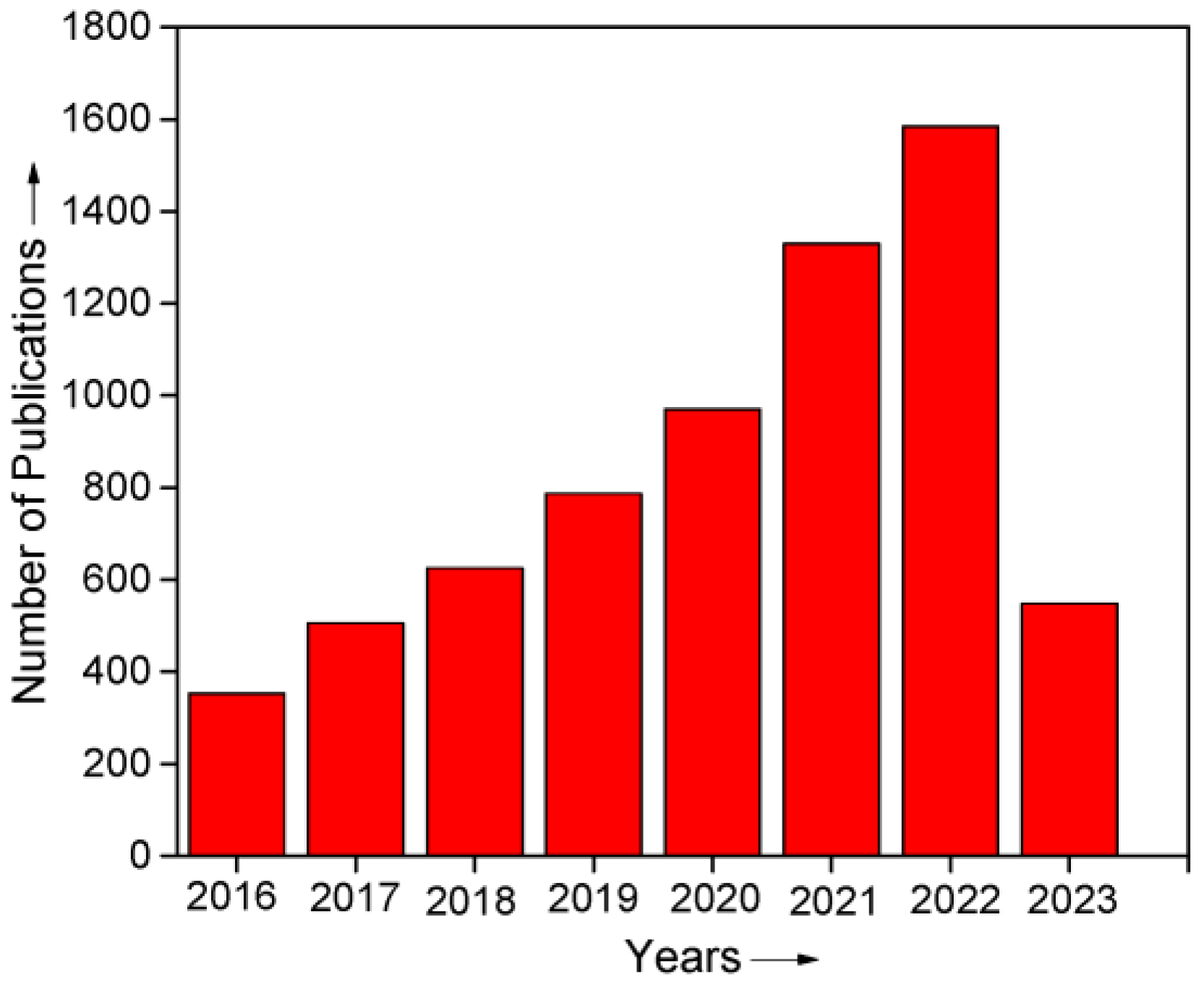

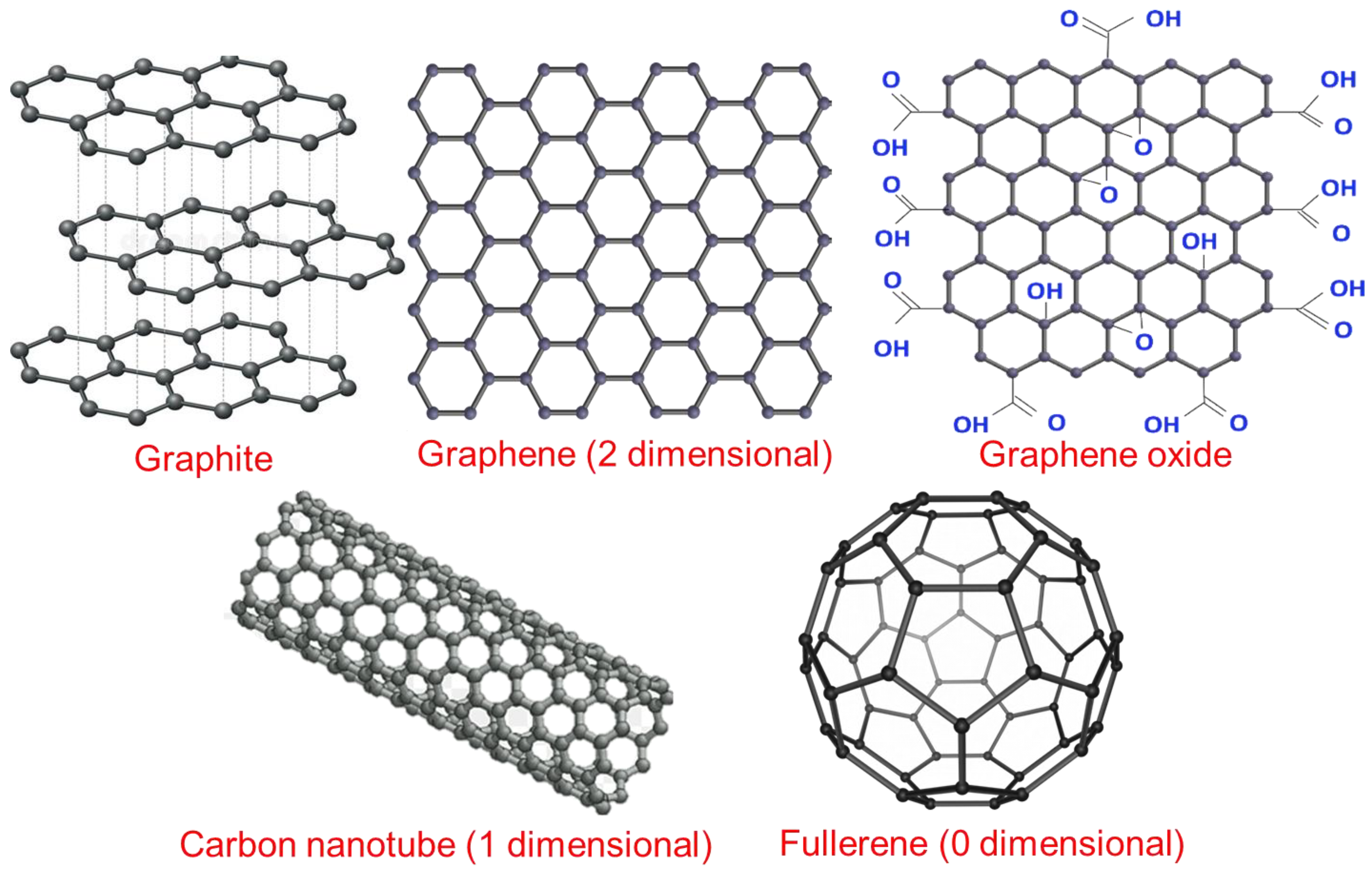




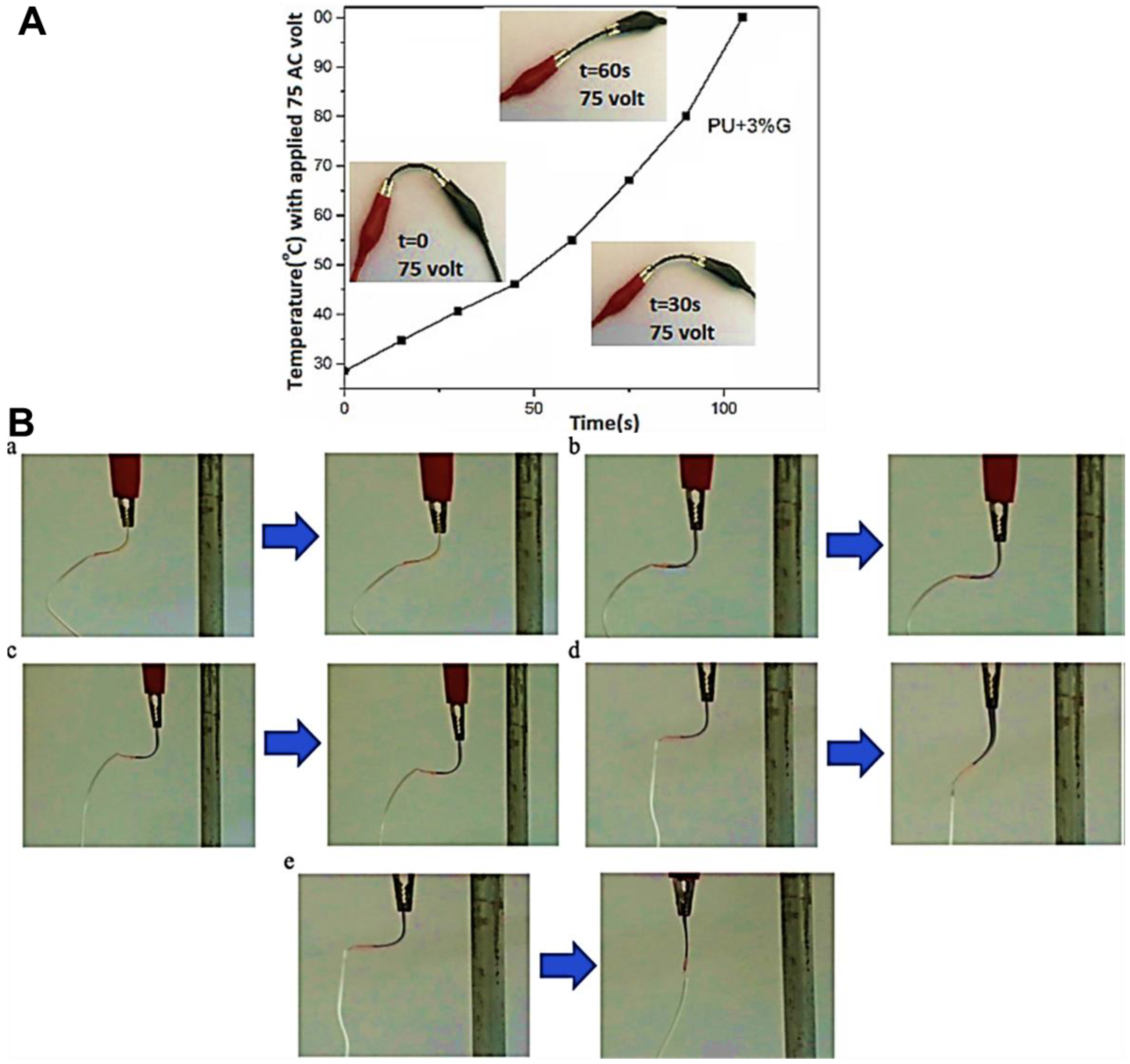

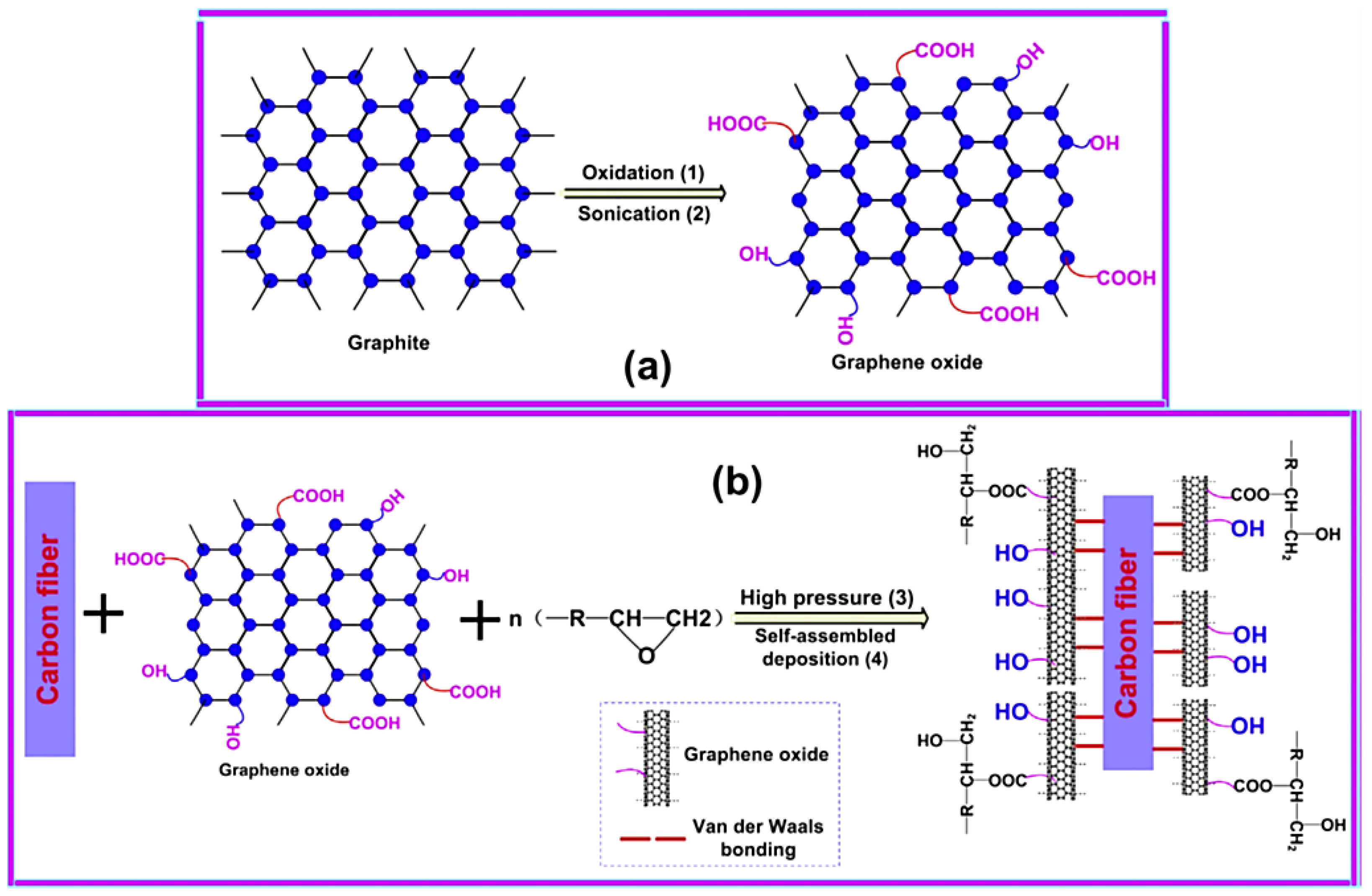

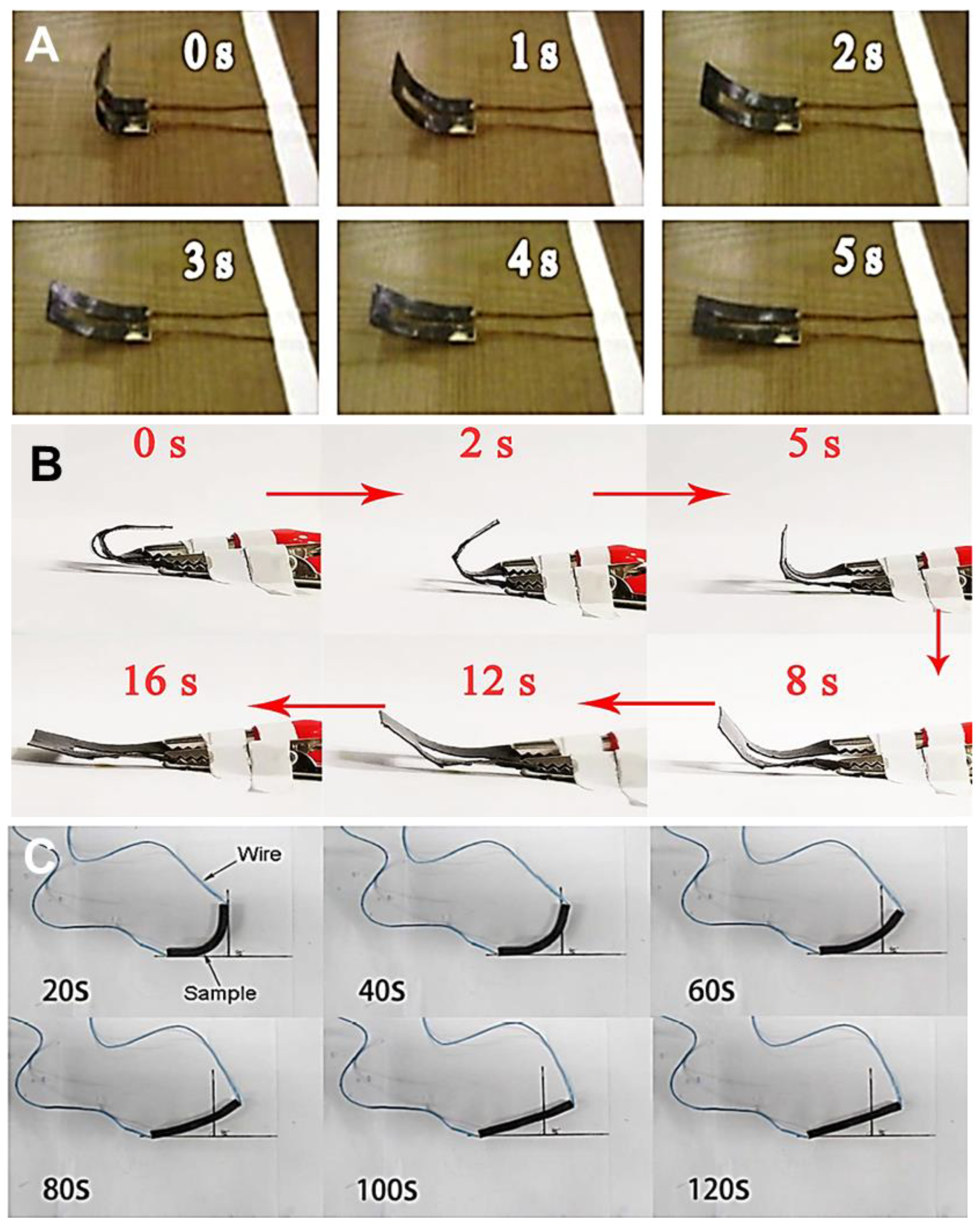
| Sample | Shape Fixity (%) | Shape Recovery (%) (Thermal: 60 °C) | Shape Recovery (%) (Electrical: 75 V at 60 s) |
|---|---|---|---|
| PU | 65 ± 2 | 90 ± 2 | Not Recovered |
| PU + 1% G | 71 ± 3 | 94 ± 2 | Not Recovered |
| PU + 1.5% G | 78 ± 2.2 | 94 ± 3 | Not Recovered |
| PU + 2% G | 82.2 ± 4 | 98 ± 2 | 95 |
| PU + 3% G | 83.4 ± 1 | 100 | 100 |
| Sample | Nanocomposite Dimensions | Applied Voltage or Current | Shape Recovery Time or Ratio | Highest Temperature (°C) | Ref. |
|---|---|---|---|---|---|
| Epoxy/reduced graphene oxide paper | Thickness, 0.1 cm | 6 V | 5 s | 240 | [122] |
| Epoxy/graphene oxide | 80 × 6 × 2 mm3 | - | 90% | 74 | [119] |
| Epoxy/graphene | 5 mm | 5–10 mA | 60 s | 60 | [124] |
| Epoxy/graphene oxide/carbon fiber | 50 × 15 × 0.30 mm3 | - | 20 min/100% | 80 | [125] |
| Waterborne epoxy/graphene oxide | 30 × 4 × 0.25 mm3 | 2–9 V | 3–7 s/> 90% | 25 | [123] |
| Polyurethane/epoxy resin/functional graphene | 25 × 5 × 1 mm3 | - | 96% | 50 | [126] |
| Polymer | Nanofiller | Actuation Type | Properties | Ref. |
|---|---|---|---|---|
| Polyurethane | Graphene | Electroactive | Shape recovery force: 1.8 MPa cm−3 | [110] |
| Polyurethane | Graphene | Light-active | Nanofiller dispersion; shape recovery ratio | [111] |
| Polyurethane | Multi-layer graphene oxide | Electroactive | Shape recovery ratio: 83%; Shape recovery time: 7.6 s | [112] |
| Polyurethane | Graphene oxide, reduced graphene oxide, poly(ε-caprolactone functional graphene oxide | Thermoresponsive | Shape recovery > 95% | [113] |
| Polyurethane | Graphene | Electroactive | Percolation threshold: 1.5 wt.%; shape recovery: 100% in 60 s; shape fixity: 83.4% | [115] |
| Epoxy | Graphene oxide | Thermoresponsive | Thermal deformation mechanism; Ttrans | [119] |
| Epoxy | Graphene oxide-coated carbon fiber | Electroactive | Electrical-current-induced Joule heating effect; shape recovery: 95% | [120] |
| Epoxy | Reduced graphene oxide | Electroactive | Shape recovery at 6 V | [122] |
Disclaimer/Publisher’s Note: The statements, opinions and data contained in all publications are solely those of the individual author(s) and contributor(s) and not of MDPI and/or the editor(s). MDPI and/or the editor(s) disclaim responsibility for any injury to people or property resulting from any ideas, methods, instructions or products referred to in the content. |
© 2023 by the authors. Licensee MDPI, Basel, Switzerland. This article is an open access article distributed under the terms and conditions of the Creative Commons Attribution (CC BY) license (https://creativecommons.org/licenses/by/4.0/).
Share and Cite
Kausar, A.; Ahmad, I.; Aldaghri, O.; Ibnaouf, K.H.; Eisa, M.H. Shape Memory Graphene Nanocomposites—Fundamentals, Properties, and Significance. Processes 2023, 11, 1171. https://doi.org/10.3390/pr11041171
Kausar A, Ahmad I, Aldaghri O, Ibnaouf KH, Eisa MH. Shape Memory Graphene Nanocomposites—Fundamentals, Properties, and Significance. Processes. 2023; 11(4):1171. https://doi.org/10.3390/pr11041171
Chicago/Turabian StyleKausar, Ayesha, Ishaq Ahmad, O. Aldaghri, Khalid H. Ibnaouf, and M. H. Eisa. 2023. "Shape Memory Graphene Nanocomposites—Fundamentals, Properties, and Significance" Processes 11, no. 4: 1171. https://doi.org/10.3390/pr11041171
APA StyleKausar, A., Ahmad, I., Aldaghri, O., Ibnaouf, K. H., & Eisa, M. H. (2023). Shape Memory Graphene Nanocomposites—Fundamentals, Properties, and Significance. Processes, 11(4), 1171. https://doi.org/10.3390/pr11041171











